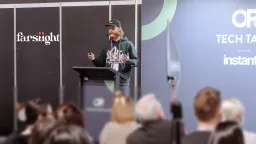
Actionable Performance Marketing Tips for Retailers in a Challenging Economy
At Online Retailer, we common theme of conversation from retailers was how to achieve better efficiency from paid media. This article shares our top tips for making sure your budget is working effectively for you, focusing on strategic budget allocation, campaign optimisation, and precise targeting to improve performance and maximise ROI.
At Online Retailer, the team at farsiight spoke with over 100 retailers across various industries and stages of maturity. The most common question we received was, “How do I gain better efficiency from my paid media spend?” or simply, “How do I get more for less?”
Given the current economic climate and the decline in retail sales over the last few quarters, this question is a hot topic for all our clients. I wanted to share some key recommendations based on strategies we deploy for our retail and eCommerce clients at farsiight.
Recommendation #1 – Avoid This Media Allocation Mistake at All Costs
We’ve audited countless eCommerce brands over the past two years and frequently encountered a costly mistake made by both in-house teams and agencies. The error is over-allocating media investment to lower/bottom-of-the-funnel activity on Google and Meta/social platforms.
Initially, this approach might seem effective—investing more in brand campaigns on Google and retargeting on Meta can make your ROAS soar. However, these results often don’t translate into significant revenue increases due to the lack of campaign incrementality.
To illustrate, consider this brand, a pure DTC player generating over 8 figures. Their data shows a steep decline in new customer acquisition over two years. This happened because the brand set an aggressive ROAS target, prompting their agency to focus heavily on lower funnel activities, sacrificing new customer acquisition.
As the brand aggressively marketed to previous customers, they began exhausting their database, noticing performance declines.
Recommendation #2 – Divest from Low-Incremental-Value Campaigns (e.g., Google Ads Brand Campaigns)
Google Ads brand campaigns often top our list of low-incremental-value efforts. Reducing or eliminating these campaigns frequently has minimal revenue impact. We recommend running brand campaigns only in cases of high competition where competitors bid on your branded terms or when promoting sales.
Surprisingly, many brands don’t realise that branded searches are included in PMAX campaigns by default. PMAX seeks the path of least resistance to conversions, often prioritising branded terms. We advise excluding brand from PMAX, running a branded search campaign with manual bidding, and setting up a standard shopping campaign for branded terms to maintain control over spending.
We’ve saved clients millions by implementing this strategy. Take this as a cue to assess your brand spending—it might be more than you realise.
Read more about our thoughts on Google Ads for Brand here.
Recommendation #3 – Tighten Campaign Exclusions on Meta
Despite discussions about using singular catch-all campaigns for awareness with Advantage Plus Shopping, we’re not fully convinced at farsiight. We still use TOF/MOF/BOF campaigns to control spend and ad creative at each funnel level.
Ensure you have proper exclusions in place. For instance, your top-of-funnel campaign should exclude previous purchasers and website traffic to focus on new customer acquisition. Advantage Plus Shopping functions similarly to PMAX, pursuing easy conversions without guardrails.
We recently audited a household name brand in the online furniture category that lacked exclusions in their campaigns. Implementing exclusions might cause a drop in reported results but usually improves metrics like MER (marketing efficiency ratio).
While we don’t oppose retargeting campaigns on Meta like we do with branded campaigns on Google, we view them similarly in terms of incrementality. If your brand has a strong retention strategy through email and SMS, we recommend limiting spending on these campaigns. We generally suggest a 70/30 budget split for new customer acquisition vs. retargeting and retention on Meta.
Recommendation #4 – Kill All Meta Campaign Objectives Outside of Conversion
We firmly believe that non-conversion campaign objectives on Meta are a waste of media spend, with few exceptions like lead gen campaigns for email list building or if you’re a 9+ figure brand with a conversion campaign spending limit.
If you’re running traffic or awareness campaigns on Meta without the conversion objective being a purchase, we strongly advise discontinuing them.
Recommendation #5 – Review Your Product Marketing Strategy
Brands often attempt to advertise their entire range on Google, which harms media efficiency, especially with large SKU ranges and limited budgets.
If you’re using a single PMAX campaign for all SKUs or have limited segmentation, we recommend rethinking your strategy to align with business objectives. Given the focus on profitability, consider segmenting campaigns into “High Margin” and “Low Margin” categories based on GP margin. This allows more budget allocation to high-margin SKUs, positively impacting net profit.
Beyond segmentation, review your product feed to exclude items with limited size ranges or poor historical performance. Prioritise products that yield the best outcomes through paid media versus other channels.
In summary
In today’s competitive landscape and economy, achieving efficiency in paid media is crucial for retail success.
By strategically allocating resources, focusing on high-impact campaigns with better exclusions, and continuously refining your approach, you can maximise your return on investment.
Remember, it’s not about spending less but spending smarter. By applying these strategies, you’ll ensure your media budget is truly working for you, driving results that will see you thrive during tougher times.

Ben Somerville
As a Director of the agency Ben wears many hats. No literally, he wears a different hat to work every day. Is it because his hairline has packed its bags to head north or that he just loves hats remains one of the great farsiight mysteries. When he’s not in the office chewing our ear off about the latest podcast he’s listened to, Ben is off chasing his dreams as an amateur bowhunter, crossfitter, snowboarder and family man. Perhaps one too many Joe Rogan podcasts for Ben…
Like what you read?
Learn more about digital, creative and platform strategies below.
